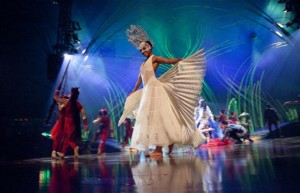Theater Impressions: Cirque du Soleil’s “Amaluna” — Diane Paulus Turns “The Tempest” Into a Circus
A.R.T artistic director Diane Paulus, entrepreneur extraordinaire, seems to have plucked impulse for character and meandering plot from a watered (down) idea of “The Tempest.”
Amaluna, Cirque du Soleil, Directed by Fernand Rainville and Diane Paulus. Currently running in Montreal, CA, through July, and scheduled to play other Canadian cities, Quebec City, Toronto, and Vancouver, through November, 2012.
By Joann Green Breuer
The post-modern world performance phenomenon that is Cirque du Soleil: companies of circuses that proffer a message in one ring, animal-free extravaganzas that are staged in sturdily rigged tents seating thousands, simultaneously. Cirque du Soleil’s 28 years of repertory is made up of imaginatively, if incomprehensibly, titled spectaculars: O (water), Ovo (insects), Quidnunc (teen imaginings), Iris (Hollywood), Mystère (Las Vegas), Dralion, Ka, Zarkana, Zumanity, etcetera). Two icons of entertainment — Michael Jackson, the Beatles — have shaped Cirque du Soleil shows as well.
Amaluna is the latest Cirque du Soleil display of seemingly impossible acrobatic human feats accompanied by a blaring beat and mega-monetary heat. It is said that Guy Laliberte, with Gilles St-Croix, socially conscious founders and “Artistic Guides” of the Cirque could, maybe should, bailout Greece.
Amaluna’s theme is, purportedly, women. Fernand Rainville is credited as “Director of Creation.” Diane Paulus, artistic director of the American Repertory Theater at Harvard University, is named “Director.” Who did what is unknittable. Both claim to have desired to create a world of women with male intrusions: Rainville emphasizes love and Paulus emphasizes community. Nothing to argue with there, save the cliches.
And no argument that they are able to gather to their platform, and in the airspace above it, ahhh-inspiring acrobats from all continents. Be prepared for your popcorn to fall from your dropped jaw: high fliers (trapeze artists), lira swingers, wire walkers (women on point and in high heels no less), swimmers (water is becoming a Cirque du Soleil tradition -— as it is for Laliberte’s charity, One Drop, which brings clean water to rural areas), twirlers, teeter boarders somersaulting in air and landing on each others’ shoulders, unicyclists in unison, uneven bar maidens in balletic twists, pole climbers and sliders, and the requisite circus clowns.
Some particularly impress amid the manipulations:
Edouard Doye (France): the romantic lead, young Romeo, who climbs poles and slips down in an instant, missing cracking his sweet head on the unforgiving stage floor by inches -— again and again
Viktor Kee (Ukraine): Caliban-ish serpent, with jiggling tail, juggling balls, and charming insouciance sidling among the audience and showing off for them
The clown couple, used as segue and contrast, Nathalie Claude (Canada) and Pepe Plana (Spain), is often not cringe inducing, winding in and out of the conventional coat reversal with studied aplomb, and managing to develop their own love story through almost wistful slapstick.
Lara Jacobs Rigolo (Switzerland): to my mind, and to my surprise, the dazzler of the evening. She is termed “Balance Goddess.” Nothing could be more appropriate. Goddess, indeed. From little twigs to enormous, spooned sticks, with one hand holding, one hand placing, and one foot picking up one graduated wood at a time, she creates a masterpiece of sculptural balance. The living sculpture holds while the audience holds its collective breath. To breathe may be to disrupt it. No music, no applause. Simply, the sheer, silent skill, which passes as magic.
Does Amaluna add up? Does it make the feminist sense its creators claim to have intended? What does that title signify? Mother Moon? She Loves Moon? I am Moon? And if the show does not mean but be, does that matter? It is a circus, after all . . .
Diane Paulus, entrepreneur extraordinaire, seems to have plucked impulse for character and meandering plot from a watered (down) idea of The Tempest. Not Prospero but Juno, the woman in the rig ring of moon, presides over an erratically paced array of scenes: unruly barrage of aliens, leapers and bounders, swingers and singers, as her daughter and handsome swain make pre-erotic contact, their pursuit gleefully impeded, their final coupling predictable. This is young adult entertainment. For those looking for reward — keep expectations early teenward.


Just to clarify things a bit:
Those balanced items were not twigs, but palm fronds. The army of invaders were shipwrecked Ferdinand (here Romeo) and his friends, brought to the island by the ruler Prospera who creates a tempest to get a husband for her daughter Miranda. The residents of the island are all female (except for Caliban), including the slithery creatures and defended by a troop of Amazons — all of whom had a second purpose of entertaining with acrobatic feats …
Amaluna is the Goddess of the Moon, and represented by Juno, swooping up and down and doing aerials while singing in a gorgeous soprano, and she did not control what was going on below her. Prospera did. Hope this helps, and at least you had a good time… that’s what it’s all about. A Circus.
Thanks for the correction: palm fronds…but even knowing what they are, the act remains incredibly mesmerizing.
Yes, women islanders and female authority, but heterosexual urgency. I don’t think Shakespeare would object. He made good use of a few clowns and women in male drag, too.